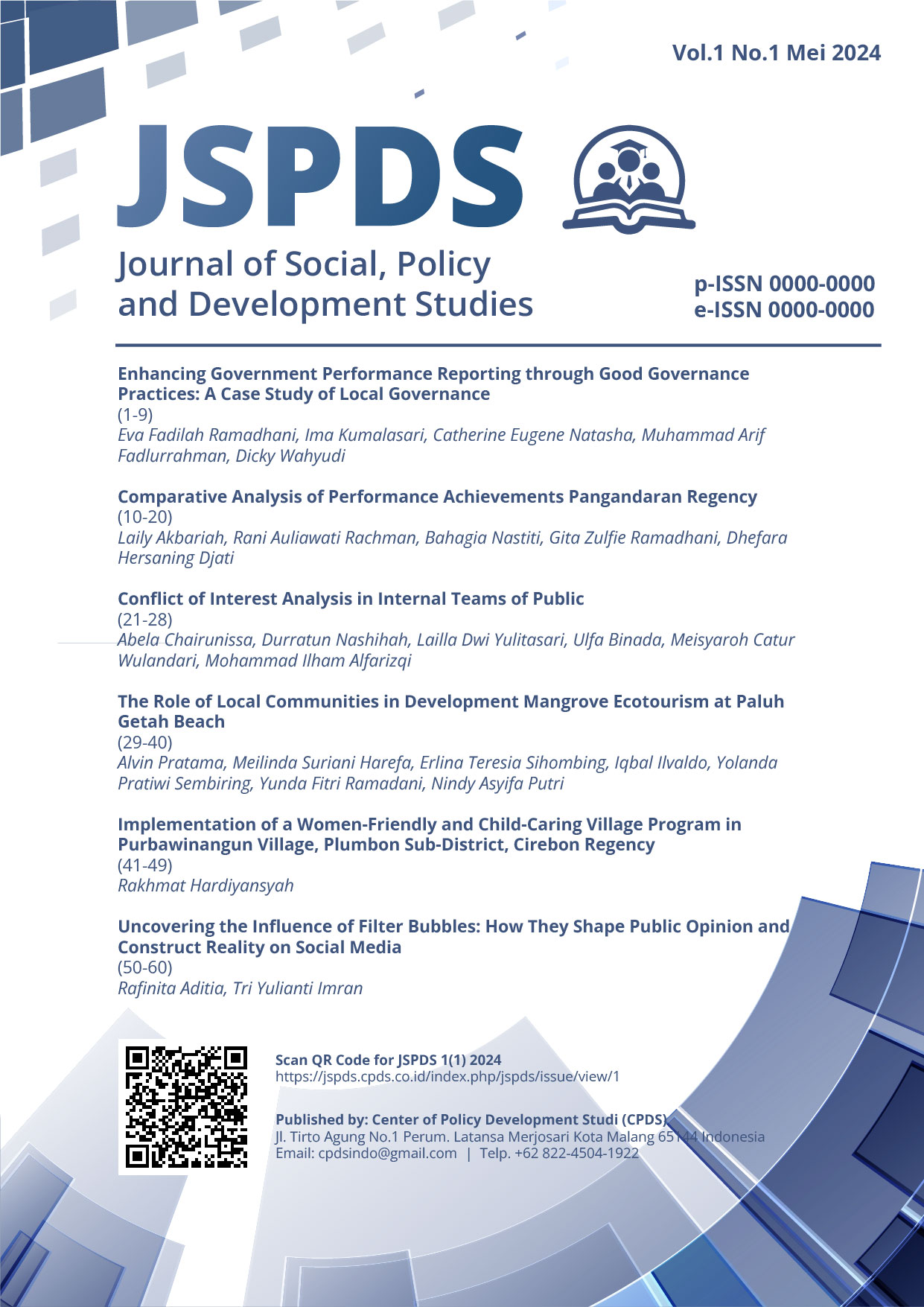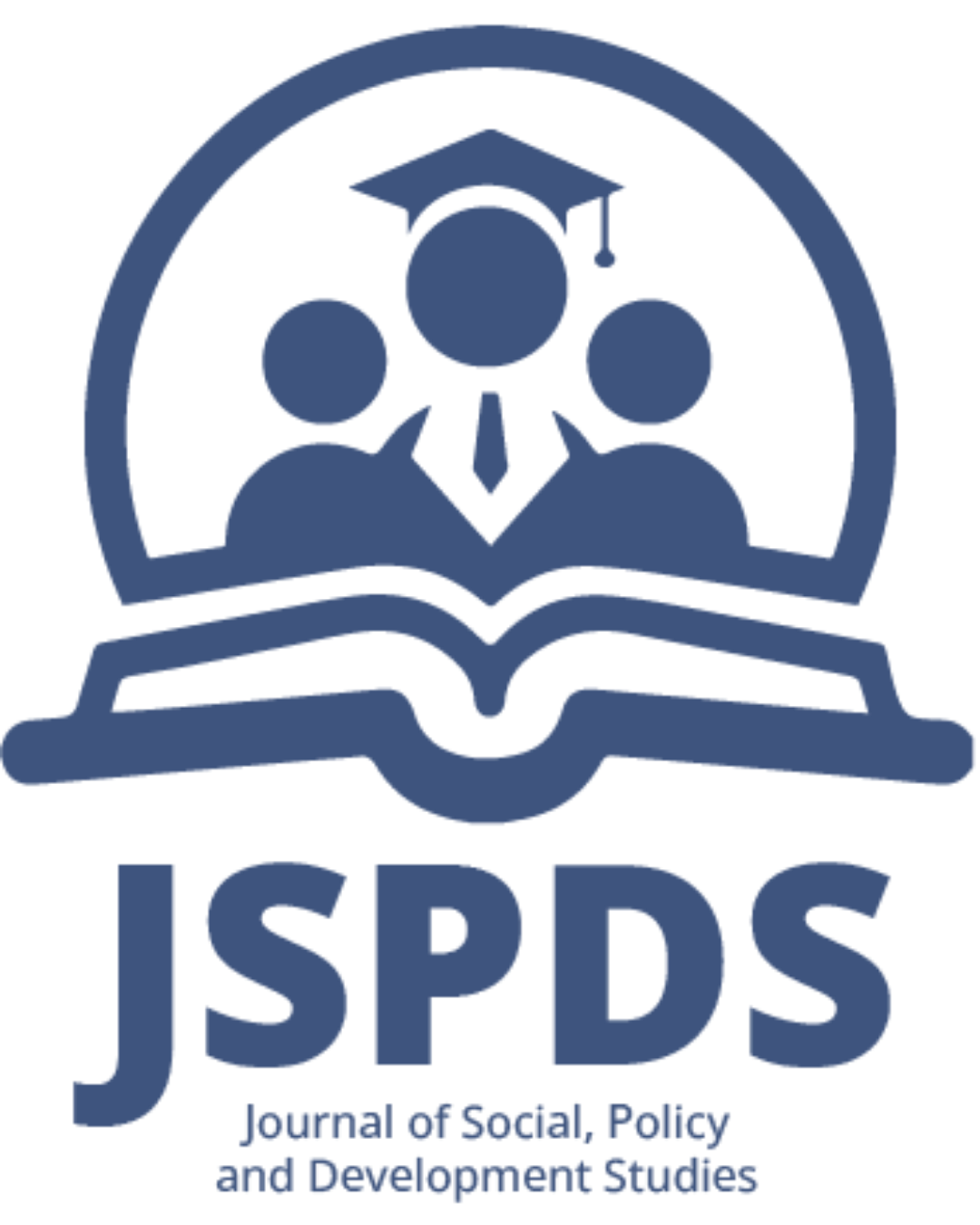Uncovering the Influence of Filter Bubbles: How They Shape Public Opinion and Construct Reality on Social Media
DOI:
https://doi.org/10.65119/jspds.v1i1.11Keywords:
filter bubble, public opinion , social impact, social mediaAbstract
Social media has become an integral part of everyday life, facilitating the exchange of information and interaction between individuals globally. However, beyond the convenience and connectivity it offers, social media also has complex and sometimes undesirable impacts. One phenomenon that is gaining increasing attention is filter bubbles, a term that refers to information environments personalized by social media platform algorithms, which tend to reinforce existing views and limit exposure to alternative points of view. This research analyzes the impact of filter bubbles on the formation of public opinion and the construction of reality on social media. Findings suggest that filter bubbles amplify ideological polarization, limit the quality of political participation, and create an environment that strengthens confirmation bias. Its impact is not only limited to forming opinions, but also affects the mental health of individuals and the formation of their identity. Efforts to overcome the negative impacts of filter bubbles require collaboration between government, social media platforms, academics and civil society. Increasing media and information literacy, transparency in the use of personalization algorithms, and the promotion of inclusive and open dialogue about the impact of social media are important steps in facing this challenge. Although filter bubbles have significant negative impacts, the positive potential of social media in giving voice to marginalized individuals and facilitating social change must also be recognized.
References
Aditya, R. (2021a). Fenomena Phubbing: Suatu Degradasi Relasi Sosial Sebagai Dampak Media Sosial. KELUWIH: Jurnal Sosial dan Humaniora, 2(1), 8–14. https://doi.org/10.24123/soshum.v2i1.4034
Aditia, R. (2021b). Literasi Meningkatkan Kecerdasan Bermedia Bagi Generasi Z. Jurnal Ilmu Komunikasi, 2(2). 107-119
Aditia, R., & Hektanti, N. L. (2023). Analysis of Structures and Levels in Communication Networks. Social Science Studies, 3(2), 092–104. https://doi.org/10.47153/sss32.6 152023
Aridho, A., Situmeang, T. A., Tinambunan, D. R., Ramadhani, K. N., Lase, M. W., & Ivanna, J. (2024). Peran Media Massa Dalam Membentuk Opini Publik: Demokratisasi Pasca-Reformasi. IJEDR: Indonesian Journal of Education and Development Research, 2(1), 206–210. https://doi.org/10.57235/ijedr.v2i1.1693
Aridor, G., Goncalves, D., & Sikdar, S. (2020). Deconstructing the Filter Bubble: User Decision-Making and Recommender Systems. Fourteenth ACM Conference on Recommender Systems, 82–91. https://doi.org/10.1145/3383313.3412246
Bina, M. A. H. (2021). Fenomena Hate Speech Di Media Sosial Dan Konstruk Sosial Masyarakat. Jurnal Peurawi: Media Kajian Komunikasi Islam, 4(1), 92-100
Bryant, L. V. (2020). The YouTube Algorithm and the Alt-Right Filter Bubble. Open Information Science, 4(1), 85–90. https://doi.org/10.1515/opis-2020-0007
Bustanur, B., Hafizi, K., & Yuhelman, N. (2022). Analysis Of The Filter Bubble Algorithm In The Search For Information On The Internet. Jurnal Teknologi Dan Open Source, 5(2), 136–141. https://doi.org/10.36378/jtos.v5i2.2637
Chitra, U., & Musco, C. (2020). Analyzing the Impact of Filter Bubbles on Social Network Polarization. Proceedings of the 13th International Conference on Web Search and Data Mining, 115–123. https://doi.org/10.1145/3336191.3371825
Dharma, F. A. (2018). Konstruksi Realitas Sosial:Pemikiran Peter L. Berger Tentang Kenyataan Sosial. Kanal: Jurnal Ilmu Komunikasi, 7(1), 1–9. https://doi.org/10.21070/kanal.v6i2.101
Faulina, A., Chatra, E., & Sarmiati, S. (2020). Peran buzzer dan konstruksi pesan viral dalam proses pembentukan opini publik di new media. JRTI (Jurnal Riset Tindakan Indonesia), 7(1), 1. https://doi.org/10.29210/30031390000
Hadiwijaya, A. S. (2023). Sintesa Teori Konstruksi Sosial Realitas Dan Konstruksi Sosial Media Massa. Dialektika Komunika: Jurnal Kajian Komunikasi dan Pembangunan Daerah, 11(1), 75–89. https://doi.org/10.33592/dk.v11i1.3498
Illahi, N. K., & Aditia, R. (2022). Analisis Sosiologis Fenomena dan Realitas Pada Masyarakat Siber. Jurnal Multidisiplin Dehasen (MUDE), 1(2). https://doi.org/10.37676/mude.v 1i2.2217
Keijzer, M. A., & Mäs, M. (2022). The complex link between filter bubbles and opinion polarization. Data Science, 5(2), 139–166. https://doi.org/10.3233/DS-220054
Liu, P., Shivaram, K., Culotta, A., Shapiro, M. A., & Bilgic, M. (2021). The Interaction between Political Typology and Filter Bubbles in News Recommendation Algorithms. Proceedings of the Web Conference 2021, 3791–3801. https://doi.org/10.1145/3442 381.3450113
Masrour, F., Wilson, T., Yan, H., Tan, P.-N., & Esfahanian, A. (2020). Bursting the Filter Bubble: Fairness-Aware Network Link Prediction. Proceedings of the AAAI Conference on Artificial Intelligence, 34(01), 841–848. https://doi.org/10.1609/ aaai.v34i01.5429
Mawarni, I. S., & Agustang, A. (2022). Konstruksi Sosial Masyarakat Terhadap Realitas Sosial Tradisi Si Semba’ Di Era Globalisasi (Studi Penelitian Di Daerah Kandeapi Tikala, Toraja Utara). Pinisi Journal of Sociology Education Review, 1(2), 1-10 https://doi.org/10.31219/osf.io/z3x54
Noorikhsan, F. F., Ramdhani, H., Sirait, B. C., & Khoerunisa, N. (2023). Dinamika Internet, Media Sosial, dan Politik di Era Kontemporer: Tinjauan Relasi Negara-Masyarakat. Journal of Political Issues, 5(1), 95–109. https://doi.org/10.33019/jpi.v5i1.131
Nurmansyah, Fadhil. (2021). Hiperrealitas pada Media Sosial Pengguna Instagram di Kalangan Mahasiswa. Ad-Dariyah: Jurnal Dialektika, Sosial dan Budaya, 2(2), 1–15. https://doi.org/10.55623/ad.v2i2.79
Rizky, M. I., Putra, B. I., Triatmaja, R. R., Nugraha, B. A., Putra, W. A., & Radianto, D. O. (2023). Analisis Hubungan Antara Teknologi dan Politik: Studi Kasus Mengenai Pengaruh Teknik Komunikasi Digital Terhadap Partisipasi Politik. VISA: Journal of Vision and Ideas, 3(3), 545–551. https://doi.org/10.47467/visa.v3i3.4166
Saydati, A., Ikhfaniha, A., Sari, N. W., & Adawiyah, R. (2023). Pengaruh Sosial Media Dalam Perubahan Dinamika Keberagamaan. Jurnal Religion: Jurnal Agama, Sosial dan Budaya. 1(5), 1164-1171
Siregar, N. M. (2021). Strategi Komunikasi Dalam Pembentukan Opini Publik Masyarakat. Tadbir: Jurnal Manajemen Dakwah FDIK IAIN Padangsidimpuan, 3(2), 343–358. https://doi.org/10.24952/tad.v3i2.4880
Sugiyono. (2019). Metode Penelitian Kualitatif, Kuantitatif dan R&D. Bandung: Alfabeta
Wulandari, V., Rullyana, G., & Ardiansah, A. (2021). Pengaruh algoritma filter bubble dan echo chamber terhadap perilaku penggunaan internet. Berkala Ilmu Perpustakaan dan Informasi, 17(1), 98–111. https://doi.org/10.22146/bip.v17i1.423
Downloads
Published
Issue
Section
License
Copyright (c) 2024 Journal of Social, Policy and Development Studies

This work is licensed under a Creative Commons Attribution-ShareAlike 4.0 International License.









